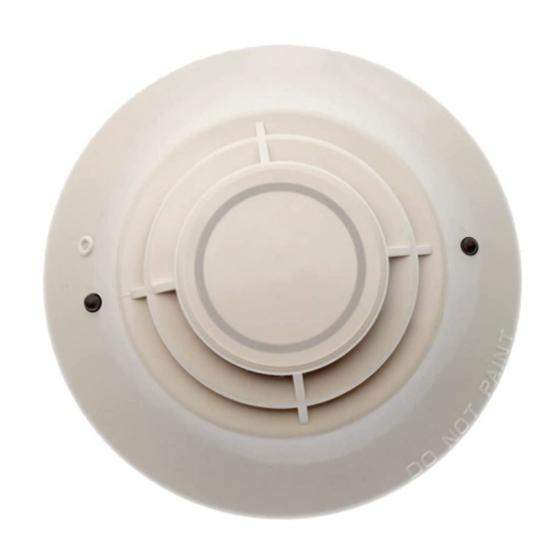Advertisement
INSTALLATION AND MAINTENANCE INSTRUCTIONS
FST-851, FST-851R, and FST-851H
Intelligent Plug-In Temperature Sensors
SPECIFICATIONS
Diameter:
Height:
Weight:
Installation Temperature:
Operating Humidity Range:
Mounting:
Voltage Range:
Standby Current:
LED Current:
Fixed Temperature Rating:
Rate-of Rise Detection:
This sensor must be installed in compliance with the control panel system
installation manual. The installation must meet the requirements of the Au-
thority Having Jurisdiction (AHJ). Sensors offer maximum performance when
installed in compliance with the National Fire Protection Association (NFPA);
see NFPA 72.
Before installing sensors, please read the system wiring and installation man-
ual thoroughly. This manual provides detailed information on sensor spac-
ing, placement, zoning, and special applications. Copies of these manuals are
available from Notifier.
GENERAL DESCRIPTION
Models FST-851, FST-851R and FST-851H are intelligent sensors that utilize a
state-of-the-art thermistor sensing circuit for fast response. These sensors are
designed to provide open area protection with 50 foot spacing capability as
approved by UL 521. Model FST-851 is a fixed temperature sensor with 135°F
fixed temperature alarm. Model FST-851R is a rate-of-rise temperature sensor
with 135° F fixed temperature alarm. Model FST-851H is a high temperature
sensor with 190° F fixed temperature alarm.
Two LEDs on each sensor light to provide a local, visible sensor indication.
Remote LED annunciator capability is available as an optional accessory (Part
No. RA400Z/RA100Z).
Notifier panels offer different feature sets across different models. As a result,
certain features of the FST-851, FST-851R and FST-851H may be available on
some control panels, but not on others. The sensors will support either Flash-
Scan™ or CLIP (Classic Loop Interface Protocol) mode. The possible features
available, if supported by the control unit include:
1.
The panel controls the LED operation on the sensor. Operational modes
are RED blink, RED continuous, GREEN blink, and off.
2.
The remote output may be synchronized to the LED operation or con-
trolled independent of the LEDs. Please refer to the operation manual for
the UL listed control unit for specific operation of these models
Models FST-851, FST-851R, and FST-851H require compatible addressable
communications to function properly. Connect these sensors to listed-com-
patible control panels only.
WIRING GUIDE
All wiring must be installed in compliance with the National Electrical Code,
applicable local codes and the Authority Having Jurisdiction. Proper wire
gauges should be used. The installation wires should be color coded to limit
wiring mistakes and ease system troubleshooting. Improper connections will
prevent a system from responding properly in the event of a fire.
Remove power from the communication line before installing sensors.
1.
Wire the sensor base (supplied separately) per the wiring diagram, Figure 1.
2.
Set the desired address on the sensor address switches, see Figure 2.
3.
Install the sensor into the sensor base. Push the sensor into the base
while turning it clockwise to secure it in place.
NO-400-004
6.1˝ (155 mm) installed in B210LP; 4.1˝ (104 mm) installed in B501
2.0˝ (51 mm)
4.8 ounces (137 gm)
–4°F to 100°F (–20°C to 38°C), FST-851 and FST-851R; –4°F to 150°F (–20°C to 66°C), FST-851H
10% to 93% Relative Humidity, Non-condensing
B210LP flanged base; B501 flange less base
15 to 32 Volts DC Peak
300 µA @ 24 VDC (one communication every 5 seconds with LED blink enabled)
6.5 mA @ 24 VDC
135°F (57°C), FST-851 and FST-851R; 190°F (88°C), FST-851H
Responds to greater than 15°F/minute; FST-851R
4.
After all sensors have been installed, apply power to the control unit and
activate the communication line.
5.
Test the sensor(s) as described in the TESTING section of this manual.
FIGURE 1. WIRING DIAGRAM:
REMOTE
ANNUNCIATOR
+
-
(+)
2
1
3
(–)
(–)
CLASS A OPTIONAL WIRING
(+)
FIGURE 2:
7
8
6
9
5
10
11
4
12
3
13
2
14
1 0
15
TENS
TAMPER RESISTANCE
The sensor base includes a tamper proof feature which when activated pre-
vents removal of the sensor without the use of a tool. See the installation
instruction manual for the sensor base for details in using this feature.
TESTING
Before testing, notify the proper authorities that the system is undergoing
Maintenance, and will temporarily be out of service. Disable the system to
prevent unwanted alarms.
All sensors must be tested after installation and periodically thereafter. Test-
ing methods must satisfy the Authority Having Jurisdiction (AHJ). Sensors
offer maximum performance when tested and maintained in compliance with
NFPA 72.
1
12 Clintonville Road
Northford, CT 06472-1653
Phone: 203.484.7161
CAUTION: DO NOT LOOP WIRE
UNDER TERMINAL 1 OR 2.
BREAK WIRE RUN TO PROVIDE
SUPERVISION OF CONNECTIONS.
2
2
1
3
3
7
8
6
9
5
4
3
2
1 0
ONES
I56-3518-004R
1
C0129-02
C0162-00
Advertisement
Table of Contents

Summary of Contents for Honeywell Notifier FST-851
- Page 1 INSTALLATION AND MAINTENANCE INSTRUCTIONS FST-851, FST-851R, and FST-851H 12 Clintonville Road Northford, CT 06472-1653 Intelligent Plug-In Temperature Sensors Phone: 203.484.7161 SPECIFICATIONS Diameter: 6.1˝ (155 mm) installed in B210LP; 4.1˝ (104 mm) installed in B501 Height: 2.0˝ (51 mm) Weight: 4.8 ounces (137 gm) –4°F to 100°F (–20°C to 38°C), FST-851 and FST-851R;...
- Page 2 Test Magnet (Model No. M02-04 - optional) MAINTENANCE NOTE: Before cleaning notify the proper authorities that the system is undergoing 1. Place the optional test magnet against the cover in the magnet test maintenance, and therefore the system will temporarily be out of service. Disable area, as shown in Figure 3, to activate the test feature.
















Need help?
Do you have a question about the Notifier FST-851 and is the answer not in the manual?
Questions and answers